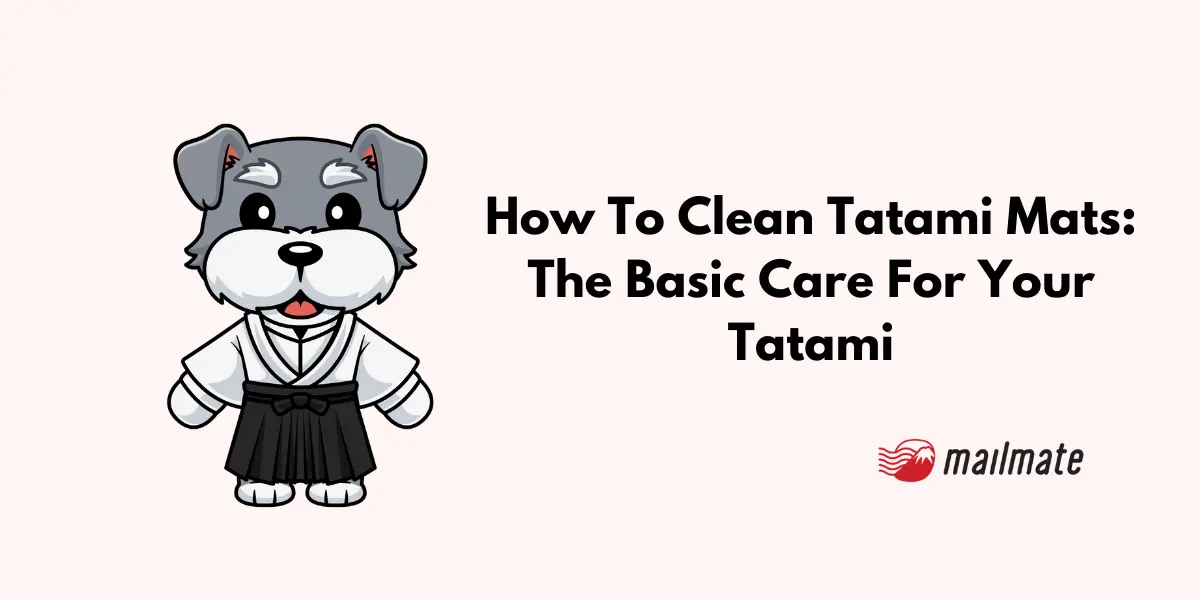How To Clean Tatami Mats: The Basic Care For Your Tatami

Properties in Japan will have two types of rooms: Japanese-style rooms (washitsu, 和室) and Western-style rooms (youshitsu, 洋室). The former rooms will have tatamis, while the latter has wooden floors.
While tatami floors aren’t the most difficult to care for, they require little maintenance to ensure they last as long as possible.
As such, we explain how to clean tatami mats and other basic tatami care you should know.
What is tatami?

Close-up image of Japanese tatami mats
Tatamis are traditional Japanese flooring mats, mainly for Japanese-style rooms. Traditionally, they are made of tightly woven rice straws. However, more modern tatami mats might use compressed wood chips or polystyrene foam for a lighter and more durable mat.
Most Japanese apartment layouts are measured by tatami mat size. However, just because rooms are measured by tatami does not mean they are tatami rooms. Instead, tatami rooms are usually colored green on the layout map to reflect their color.
How do you care for Japanese tatami mats?
Before we get into any specifics, here are general cleaning and care tips for your tatami:
Dos
Let the tatami “breathe.”
Vacuum or brush along with the grain.
Sit on the floor with a low table and sitting pillows.
Use furniture foot covers or protection pads.
Use dehumidifiers or moisture absorbers.
If you have to lay furniture, use leg covers.
Keep your tatami mats dry.
Don’ts
No shoes on the tatami mats.
No pets in the tatami room.
No heavy furniture on the tatami.
Do not lay anything over the tatami for a long period. Futons are fine, but you must put them away during the day.
Do not drag items like a chair across, as it will damage the tatami grains.
Do not place tatami in direct sunlight.
Do not smoke in a tatami room. The mats will absorb cigarette smoke and the tobacco smells.
Looking for furniture for your akiya house? Check out this guide to the 10 best furniture stores in Japan!
General cleaning tips for tatami mats
These two tips are important for knowing how to clean tatami mats regularly.
1. Vacuum along the grain, regularly
While you can soft-bristled broom to brush away dust and hair, a vacuum cleaner removes the smaller dust particles more efficiently.
Do not use the brush attachment when using a vacuum cleaner, as it can be too abrasive for the tatami. If possible, use the lower power setting.
Additionally, always go along with the grain to avoid damaging the tatami surface.

2. Use a dry cloth for deeper cleaning
After vacuuming, you can wipe the surface with a dust cloth along the grain.
Avoid using a wet or damp cloth. Tatami is absorbent and can cause mold to grow. You can use a hair dryer to help dry out the area.
Look for 畳用クリーナー (tatami cleaner) to help you with cleaning your tatami mats and follow their instructions.
Dealing with tatami mold
One of the most common things you will encounter is seeing mold on your tatami mats.
Don’t freak out. Continue reading to learn how to clean tatami mats mold.
How to prevent mold on tatami mats
To prevent mold growth, ensure your living space is well-ventilated, especially during the rainy and humid summer. If you have to, open air vents, leave your windows open, use a fan to circulate air, and use a dehumidifier or moisture absorber pack.
Additionally, look at the corners of your living space, the back of your closet, and around the window frames for potential mold growth.
How to get rid of mold from tatami
It’s not too late if you found mold on your tatami.
One common household method for getting rid of tatami mold is to scrub the mold out with a small amount of ethanol (エタノール) and a small toothbrush. Do not scrub too harshly, as this can damage the tatami mat.
You can also use Kabi Kira (カビキラー), which translates to mold killer. This spray works great to eliminate mold on your walls and bathroom. However, it contains bleach, so be careful.
When using these sprays, make sure the room is ventilated by opening the window.
Dealing with tatami pests
Unfortunately, insects like mites and ticks are common even in the cleanest homes. So here, we explain how to prevent them and then how to get rid of them.
How to prevent insects on your tatami
Before any mites become an issue, use ダニスプレー (dani spray). This bottle will help deter insects from entering and staying on your tatami.
There are also tick odor and sheet repellents if you are reluctant to spray liquids on your tatami.
Additionally, you should wash your futon cover and air out your futon in the sun at least once a month.
How to get rid of tatami mites?
First, you should contact your landlord or property manager if you rent your living space. They should be able to replace the tatami mats (depending on your contract).
If not, you can place mite traps on your tatami mats, sofas, and beds. Follow the instructions on placement and disposal.
Damage and dents on your tatami
How to protecting your tatami from dents and damaged

These items above are okay to place on tatami mats
While it’s not recommended to place heavy akiya furniture on your tatami, there are cases where you have no choice.
The first advice regarding tatami is not to place large or heavy items on your mats. However, smaller furniture items such as tables, chairs, and drawers are okay.
Items with wide, flat-botted legs are better than skinny-legged items such as chairs.
Additionally, adding foam pads to the bottom of your furniture will help prevent scrapping and denting.
How to fix dents on your tatami mat
If your tatami has uneven dents, dampen the area with a wet cloth and gently rub it. The tatami will absorb the moisture, and the rubbing will help even the dent.
Frequently asked questions
Are tatami mats difficult to clean?
Frequently cleaning your tatami flooring is relatively easy as it prevents large clumps of dirt and dust from building up. Use a cloth and wipe with tatami grain for minor spills.
How often do you clean the tatami mat?
It is recommended that your tatami mat should be cleaned daily with a vacuum or a broom along with the grain. When the weather is nice, open the window for the tatami to air out.
How do you clean tatami mold?
You can try to remove the tatami mold by vacuuming or dry wiping. If that can not be done, use rubbing alcohol (ethanol) and a toothbrush to scrub out the mold. When using ethanol, be sure to open a window to ventilate the room.
In closing
Learning to care for and how to clean tatami mats helps preserve their lifespan. Regular cleaning and prevention will help prevent mold, mites, and damage.
Contact your landlord, property management company, or a professional to handle your tatami if you find any major issues.
Spending too long figuring out your Japanese mail?
Virtual mail + translation services start at 3800 per month. 30-day money-back guarantee.

